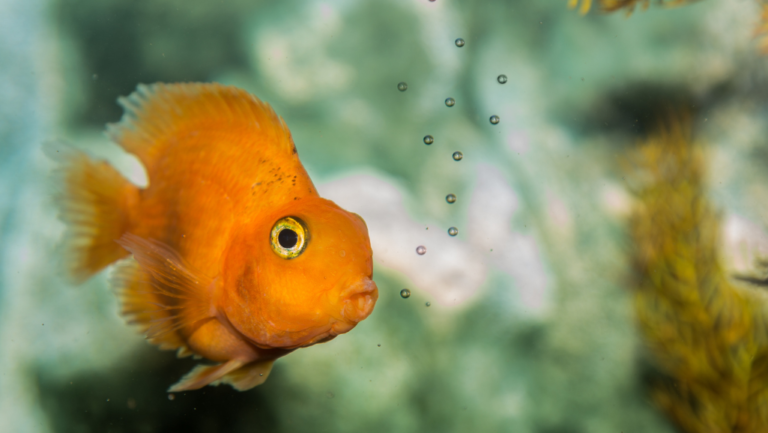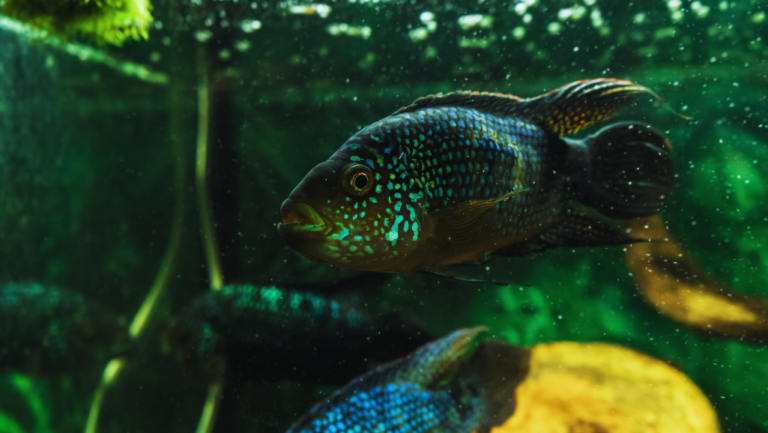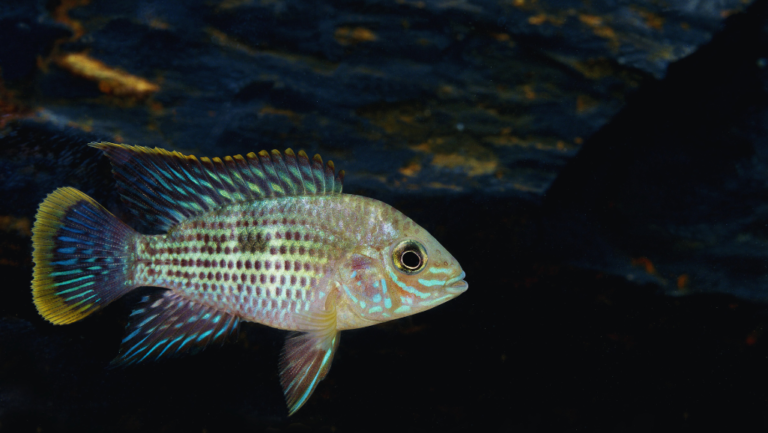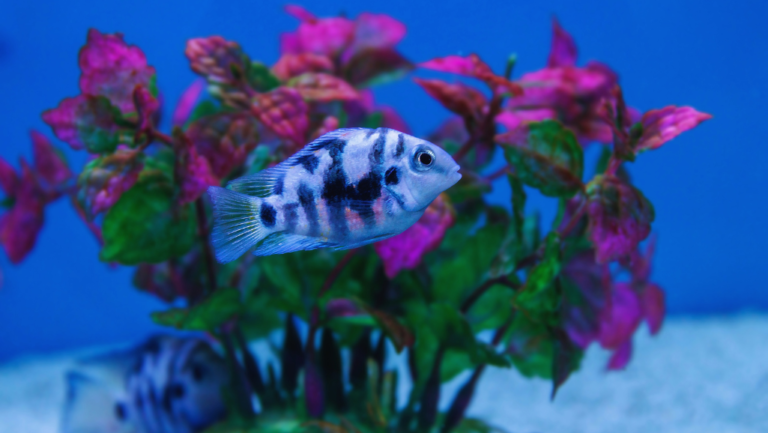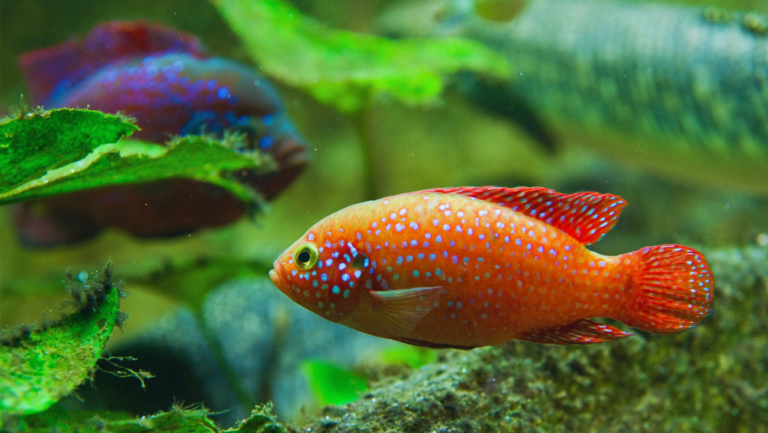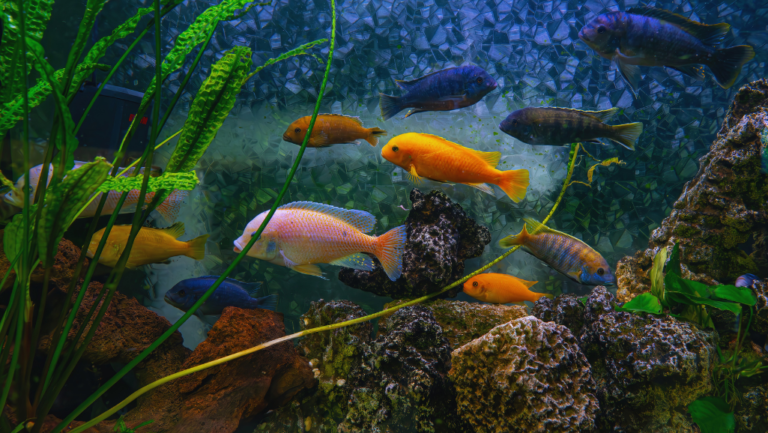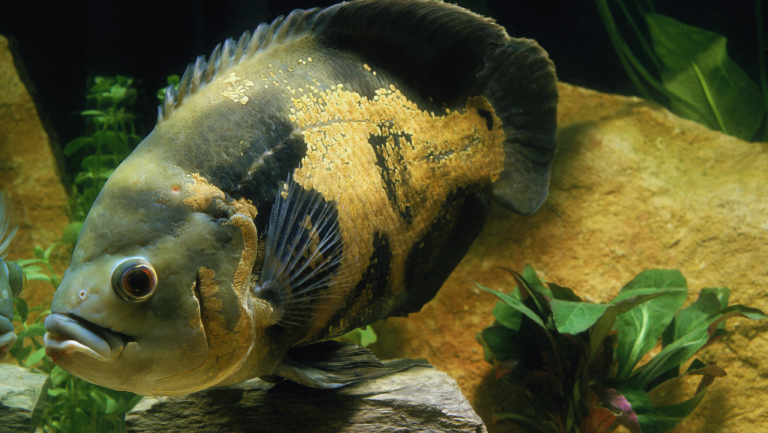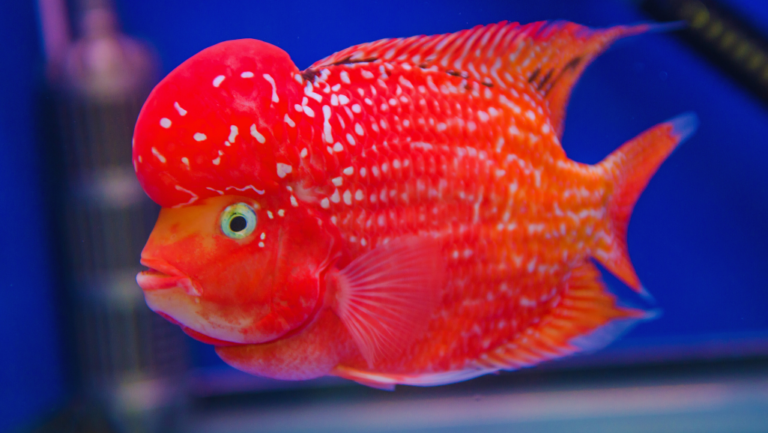Explore the exciting world of aggressive freshwater fish, where strength and beauty meet in an aquarium. These fish are known for their bold nature and hunting skills. From the fierce Wolf Cichlid to the striking Red Devil, they need respect and careful care in their homes.
Keeping these powerful fish in home tanks is challenging. They are territorial and have specific needs. We’ll look into their behaviors, what they eat, and how to keep them with other fish.
Key Takeaways
- Aggressive freshwater fish need special care and homes
- Predatory fish are important in nature’s water worlds
- Knowing how fish act helps in taking care of them
- Right tanks and food are key for aggressive fish health
- Think carefully about who to keep with these fish
Understanding Aggressive Freshwater Fish Behavior
Aggressive freshwater fish have unique traits that shape their lives in the water. These predatory fish show complex behaviors. It’s important for aquarium fans to know these behaviors to keep the tank balanced.
Territorial Instincts in Aquatic Environments
Fish often fight because of territorial instincts. Many fish claim certain areas as their own and defend them against others. This is especially true during breeding seasons when they protect their nests and young.
Predatory Nature and Hunting Strategies
Predatory fish use different ways to catch their prey. Some ambush their prey, while others chase them down. These methods can cause trouble in aquariums, especially with smaller fish around.
Factors Influencing Fish Aggression
Several things can make aquarium fish more aggressive:
- Tank size and layout
- Water quality and temperature
- Food availability
- Presence of suitable mates
- Compatibility with tank mates
Knowing these factors is key to managing aquarium bullies. It helps create a peaceful underwater world.
| Aggression Level | Species | Typical Behavior |
|---|---|---|
| High | Oscar Cichlid | Territorial, attacks smaller fish |
| Medium | Angelfish | Aggressive during breeding |
| Low | Neon Tetra | Peaceful, rarely shows aggression |
Top Aggressive Freshwater Fish Species

Aquarium fans often look for aggressive freshwater fish for their bold looks and lively actions. Let’s check out some top picks that bring excitement to your tank.
Piranhas are known for their sharp teeth and are feared in South American waters. They hunt in groups, quickly catching their prey. Oscars, from the Amazon, are territorial and can grow big in tanks.
Arowanas are loved for their sleek look and jumping ability to catch bugs. Snakehead fish have long bodies and strong jaws, eating a lot and can live on land briefly.
Wolf fish are named for their fierce nature, hunting alone with big teeth. Pacus, piranha relatives, have strong jaws for nuts and fruits but get aggressive when defending their space.
| Species | Origin | Max Size (inches) | Diet |
|---|---|---|---|
| Piranhas | South America | 14 | Carnivorous |
| Oscars | Amazon Basin | 16 | Omnivorous |
| Arowanas | Asia/South America | 48 | Carnivorous |
| Snakehead Fish | Asia/Africa | 33 | Carnivorous |
| Wolf Fish | South America | 40 | Carnivorous |
| Pacus | South America | 35 | Omnivorous |
Each of these fish needs special care and the right tank setup to do well. It’s important to do your homework and prepare well before adding these aggressive fish to your aquarium.
The Role of Predatory Fish in Aquatic Ecosystems
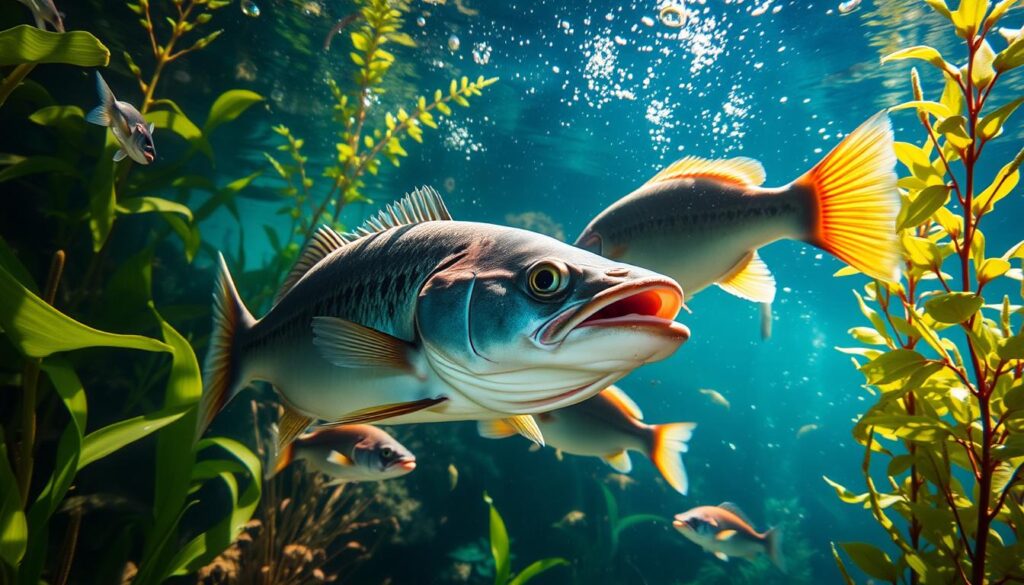
Freshwater predatory fish are key to the balance in aquatic ecosystems. They are not just impressive to watch; they are essential for their homes. These fish help keep their natural habitats healthy.
Natural Balance and Population Control
Predatory fish keep the number of smaller fish in check. This stops them from eating too much food. By doing this, they help maintain a balance in the ecosystem.
This balance affects many other creatures in the water. It changes how they live and where they go.
Impact on Biodiversity
Even though predatory fish can lower some populations, they actually help increase biodiversity. By controlling certain species, they let more kinds of life flourish. This balance makes ecosystems stronger and more diverse.
Ecological Importance of Apex Predators
At the top of the food chain, these fish show a healthy ecosystem. They change how prey fish behave, affecting their homes and what they eat. This has a big impact on the whole community in the water.
“Predatory fish are the silent guardians of our freshwater ecosystems, maintaining a delicate balance that supports life at all levels.”
Learning about the role of predatory fish helps us see them in a new light. It shows why we need to protect these important fish and their homes.
Aquarium Management for Aggressive Fish
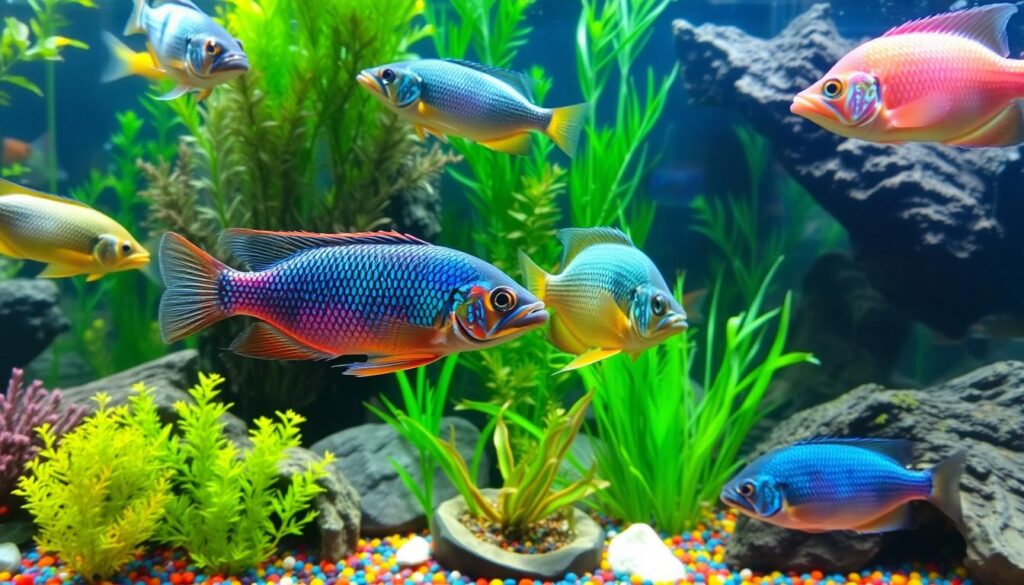
Managing freshwater aquariums with aggressive fish takes careful planning. These powerful predators need the right environment to live well with others. They can harm themselves or other fish if not set up right.
Setting up the tank correctly is key for carnivorous fish. A big tank with lots of hiding spots helps reduce stress and fights. Rocks, driftwood, and dense plants create safe zones and barriers.
Keeping the water clean is crucial for aggressive fish. Test and maintain the water’s pH, ammonia, and nitrates levels. A strong filter is needed to deal with their waste.
“Creating an environment that mimics their natural habitat is key to successful management of aggressive freshwater fish in aquariums.”
Feeding schedules are important for controlling aggression. Feed them a varied diet of high-quality proteins. Regular, controlled feedings prevent hunger aggression and keep them healthy.
- Choose tank mates carefully
- Monitor behavior regularly
- Provide ample space and territory
- Maintain consistent water conditions
By following these tips, aquarists can make a happy home for aggressive fish. This reduces conflicts and stress in the tank.
Compatibility Issues with Other Aquarium Inhabitants
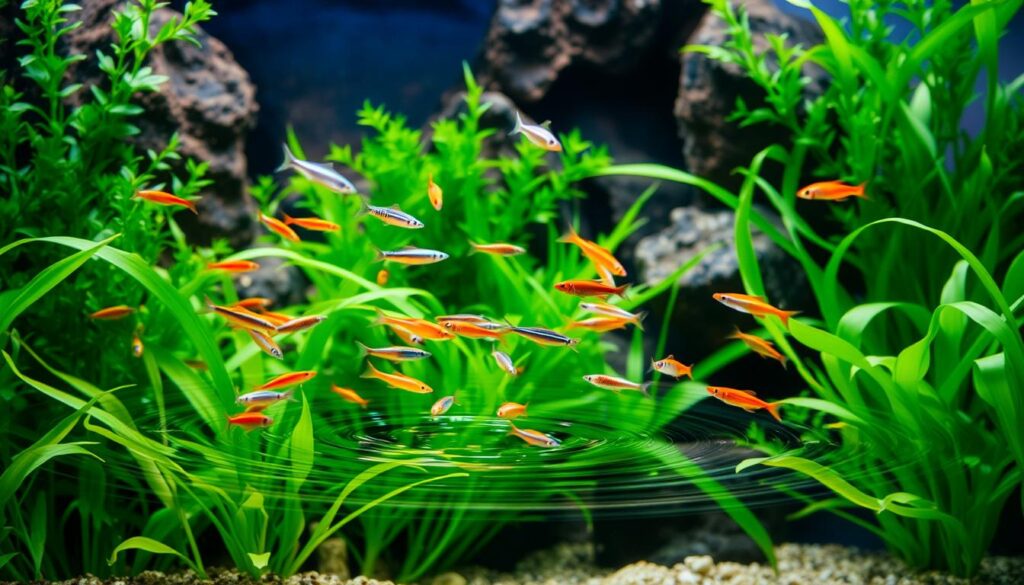
Keeping aggressive fish together in a tank can be tough. These fish often fight over territory or because they are natural predators. It’s key to know why they act this way to keep your tank peaceful.
Identifying Potential Conflicts
Fin nippers, like some cichlids, can stress and hurt other fish. Look for signs like torn fins or fish hiding a lot. Some fish are naturally mean, and others get territorial when they breed.
Strategies for Peaceful Coexistence
To lessen aggression in your tank, try these tips:
- Provide ample space and hiding spots
- Introduce fish simultaneously to prevent territorial claims
- Use plants or decorations to break line of sight
- Ensure proper nutrition to reduce food-related aggression
Tank Mates to Avoid
Some fish don’t get along because they’re too aggressive or are very different in size. Here’s a guide to help you pick the right tank mates:
| Aggressive Species | Incompatible Tank Mates | Reason |
|---|---|---|
| Oscar Cichlids | Guppies, Tetras | Size difference, predatory behavior |
| Tiger Barbs | Long-finned fish | Fin-nipping behavior |
| Betta Fish | Other Bettas, Gourami | Territorial aggression |
| Jack Dempsey Cichlids | Small, peaceful fish | Aggressive temperament |
By picking the right tank mates and using smart strategies, you can make a peaceful home for even the more aggressive fish.
Feeding Habits and Nutrition for Predatory Aquarium Fish
Carnivorous aquarium fish need special diets to do well. They thrive on high-protein foods that are similar to their natural prey. These fish often like to eat live or frozen foods like brine shrimp, bloodworms, and small fish.
Each fish species has its own way of hunting. Some wait in ambush, while others chase their food. To feed them naturally, you can hide food in plants or use feeding sticks that move like prey.
How often you feed depends on the fish’s size and type. Big predators eat less but more at each meal. Smaller fish might need to eat several times a day.
| Fish Size | Feeding Frequency | Food Type |
|---|---|---|
| Small (1-3 inches) | 2-3 times daily | Small live foods, frozen bloodworms |
| Medium (3-6 inches) | Once daily | Larger live foods, frozen fish |
| Large (6+ inches) | Every 2-3 days | Whole fish, large crustaceans |
Good nutrition is crucial for carnivorous aquarium fish. Make sure they get a varied diet. Some may need vitamin supplements if they don’t eat live foods often. Always check what your fish needs for the best health.
Aggressive Freshwater Fish: Challenges and Rewards for Hobbyists
Keeping tropical aggressive fish is both challenging and rewarding for aquarium fans. These big freshwater fish bring excitement to your tank. But, they need careful attention and thought.
Unique Personalities and Behaviors
Aggressive freshwater fish show off interesting behaviors. They form social orders, showing off their territory. This gives us a peek into their underwater world.
Specialized Care Requirements
Looking after these fish requires special knowledge and tools. They need big tanks, strong filters, and the right food. Here’s a table that shows what they need:
| Aspect | Aggressive Fish | Community Fish |
|---|---|---|
| Tank Size | 75+ gallons | 20-55 gallons |
| Diet | Live/frozen foods | Flakes/pellets |
| Tank Mates | Limited options | Many compatible species |
| Maintenance | High | Moderate |
Ethical Considerations
When keeping large freshwater fish, think about the right thing to do. Make sure they have enough space and things to do. Pick species that fit your tank size to avoid problems. Being a responsible owner keeps these fish happy and makes the hobby fun.
Conservation and Invasive Species Concerns
Aggressive freshwater fish are a big problem for protecting habitats. Many of these fish have moved into places they don’t belong. This can harm local plants and animals and upset the balance in nature.
- Predation on native species
- Competition for food and resources
- Alteration of habitats
- Introduction of diseases
To tackle these problems, conservation efforts aim to protect native homes and keep invasive fish in check. These strategies include:
- Habitat restoration
- Regulations on fish trade and release
- Public education on responsible pet ownership
- Removal of invasive species
Aquarium lovers are key in stopping invasive fish from spreading. By being responsible with their pets and not letting them go wild, they help protect nature.
| Native Species | Invasive Fish Threat | Conservation Action |
|---|---|---|
| Smallmouth bass | Snakehead | Targeted removal |
| Bluegill | Asian carp | Barrier installation |
| Brook trout | Northern pike | Habitat restoration |
Ethical Angling and Catch-and-Release Practices for Aggressive Species
Fishing for aggressive freshwater species needs a balanced approach. It’s important to respect the fish and the environment. Sustainable fishing practices are key to keeping aquatic ecosystems healthy.
Responsible Fishing Techniques
Catch-and-release fishing is a key part of ethical angling. It lets fish go back to their home, helping to keep populations healthy. When catch-and-releasing, use these tips to reduce harm:
- Use circle hooks to reduce deep hooking
- Opt for artificial lures over live bait
- Choose tackle strength that matches the target species
Minimizing Stress on Captured Fish
Handling fish with care is key to their survival. Keep these tips in mind:
- Wet your hands before touching the fish
- Support the fish’s body horizontally
- Minimize time out of water
- Use rubber nets to prevent damage to scales and fins
Legal Considerations and Regulations
Angling laws change by location and species. Know the local rules to fish responsibly:
| Regulation Type | Purpose | Example |
|---|---|---|
| Size limits | Protect breeding populations | Minimum length for keeper bass |
| Catch limits | Prevent overfishing | Daily bag limit for pike |
| Seasonal restrictions | Protect spawning periods | Closed season for walleye |
Following these ethical practices and regulations lets us enjoy fishing. It also helps with sustainable fishing and keeps our waterways safe for the future.
Conclusion
Aggressive freshwater fish are key to the health of aquatic ecosystems. They keep the balance in underwater worlds. From the fierce piranha to the striking arowana, they fascinate both fish lovers and anglers.
For those who keep fish in tanks, it’s important to understand their needs. A well-set tank, the right tank mates, and special food are a must. Anglers should also adopt ethical catch-and-release methods to protect these fish in the wild.
We must respect and protect these powerful fish. By keeping aquariums and fishing responsibly, we can help them survive and thrive. Let’s make sure these amazing creatures continue to flourish in our waters for years to come.

